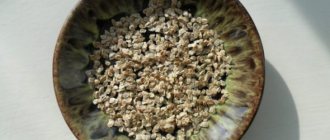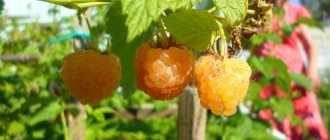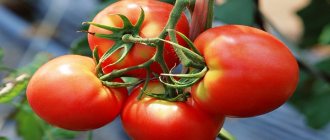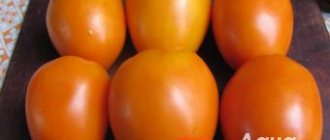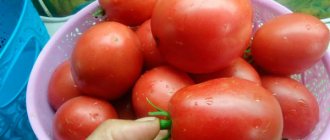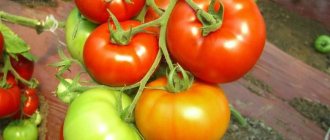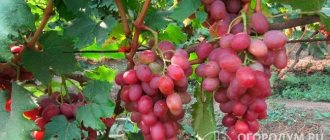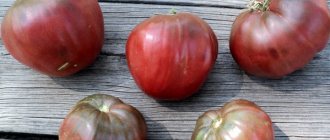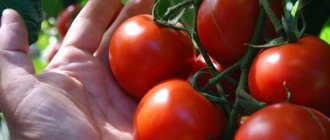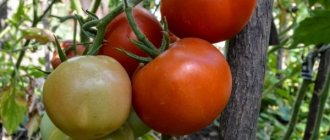This variety got its name due to the shape and color of the fruits, similar to the domes of a Christian church. And in recent years, this tomato has become very popular among summer residents from different regions of Russia.
Tomato resistance to cold and to the main diseases to which vegetable crops from the nightshade family are susceptible, large fruits, good yield - these are the main reasons for the popularity of the variety among vegetable growers. But the main thing is that there is practically no acid in ripe Golden Dome tomatoes, so they are recommended to be included in the diet of people with high stomach acidity, and they are also ideal for the diet menu.
History of variety development
This tomato variety was bred by breeders from Siberia and belongs to the famous “Siberian Garden” series of tomatoes. After breeding, the Golden Domes tomato was submitted for inclusion in the Russian State Register. This tomato first underwent several years of testing, and only in 2005 was included in the State Register. The Golden Domes tomato was patented as a breeding achievement.
Related article:
The best varieties of tomatoes for greenhouses
It should be noted that this tomato can grow and bear fruit well in garden beds in conditions where other tomato varieties die from cold in greenhouse conditions.
Deadlines
“Siberian Blood” makes itself felt by its precocity, unusual for a “giant”. Producers and the State Register evaluate the variety as mid-season. However, many amateur vegetable growers would classify it as mid-early.
The harvest begins to ripen in open ground 110–115 days after germination. Anyone who planted this variety notes a pleasant feature: the growth of fruits occurs spasmodically, very quickly. However, tomatoes ripen gradually, providing long-term benefits.
The first ovaries form in the axil of the 8th leaf. Further, they are located quite often - through one or two leaves, which guarantees a high yield.
Description of the variety
This vegetable plant is recommended to be grown in garden beds and in greenhouse conditions.
The Golden Domes tomato is classified as a determinant type, so their growth is limited - 0.9-1.5 m. Moreover, in greenhouse conditions, the height of the shoots is greater than when grown in garden beds.
The variety is mid-season, so from the moment the seeds germinate until the ripe tomatoes are harvested, it takes about 3.5-4 months.
This variety is not standard, so its shoots are less strong than those of other tomatoes. Therefore, all Golden Dome tomato bushes need to be tied up when the ovaries begin to develop, otherwise all the stems will break under the weight of the ripening fruits.
Related article:
To prevent tomatoes from becoming fattened with greens: 5 tricks
It is also required to carry out regular pinching. The exception is a pair of stepsons that must be left in the process of forming a tomato bush, one of them is located under the first inflorescence, and the other above it. Two more shoots will grow from these stepsons, as a result, each bush will be formed into 3 trunks, which is the best option for growing Golden Domes tomatoes. In this case, each plant will have a good yield, and a larger number of shoots left will lead to smaller fruits and a sharp decrease in yield.
The shoots are medium leafy. The foliage is medium in size, elongated, with sharp ends, slightly wrinkled, the edges are with small single notches, the color of the leaf blades is soft emerald.
Related article:
Once you cut it, you collect three times as much!
The first cluster with flowers appears under the 9th leaf, and each next one appears after one or two leaves.
The fruits are heart-shaped, very similar to the domes of a church. At the stage of full maturity, the color of the smooth, dense skin is bright orange. The weight of ripened tomatoes is about 400 g, and when the number of flowers is normalized, the fruits will be larger - up to 700-750 g. The pulp is fleshy, with a pleasant sour-sweet taste. Each fruit has 4 seed chambers with a small amount of seed material.
Important ! Although the fruits themselves are not prone to cracking, they can burst when overripe, as well as when there is a lack of water and fertilizer.
Ripe tomatoes can be transported any distance, but they cannot be stored for a long time - they begin to deteriorate. Therefore, the collected fruits are eaten immediately or processed.
Related article:
Growing indoor tomatoes at home on a windowsill
Characteristics
The first inflorescence on these plants is usually formed above the eighth leaf, and subsequent ones - every one or two leaves. The stalk is characterized by the presence of articulation. When planting this variety of tomatoes, there should be from seven to nine plants per square meter of land. The main feature of this type is that the yield of marketable fruits is 76%.
Fruit characteristics:
- The fruits of tomatoes of the Golden Dome variety have a flat-round, slightly ribbed shape and a fleshy consistency.
- Unripe fruits are characterized by a light green color with a dark spot at the stalk, and after ripening they become orange.
- The average weight of the fruit is from 200 to 400 grams, but with proper care they can reach 800 grams.
- The fruits have excellent taste.
- Each tomato has three to four pockets and contains an average amount of dry matter.
- These tomatoes are not suitable for long-term storage.
Most often, Golden Dome tomatoes are used to prepare fresh vegetable salads and juices.
You can compare the weight of the fruits of this variety with other varieties in the table:
| Variety name | Fruit weight |
| Golden domes | 200-800 grams |
| Rio Grande | 100-115 grams |
| Tanya | 4.5-5 kg per bush |
| f1 favorite | 19-20 kg per square meter |
| Demidov | 1.5-5 kg per square meter |
| Wild Rose | 300-350 grams |
| Honey King | 300-450 grams |
| Apple Spas | 130-150 grams |
| Thick cheeks | 160-210 grams |
| Honey Drop | 10-30 grams |
Area of application of fruits
Since the harvested crop is not stored for a long time, tomatoes are immediately processed, eaten fresh, and prepared for summer vegetable salads or snacks.
Since the fruits are large and cannot be placed in jars, the harvested crop is not used for canning. But thanks to the excellent taste, the fruits of this tomato produce very tasty tomato juice with an unusual orange color, as well as adjika, sauces and lecho.
Tomato Golden domes in section
Video
We invite you to watch a video review of the “Golden Domes” tomato variety:
| Late ripening | Early ripening | Mid-late |
| Bobcat | Black bunch | Golden Raspberry Miracle |
| Russian size | Sweet bunch | Abakan pink |
| King of Kings | Kostroma | French grape |
| Long Keeper | Brawler | Yellow banana |
| Grandma's gift | Red bunch | Titanium |
| Podsinsky miracle | The president | Slot |
| American ribbed | Summer resident | Krasnobay |
If you find an error, please select a piece of text and press Ctrl+Enter.
Diseases and pests
Although this Siberian variety is considered to be highly resistant to most diseases, it can still be affected by the following diseases:
- late blight;
- verticillium wilt;
- top rot.
Related article:
Tomato Rio Grande - description and characteristics of a super-yielding variety
Such diseases can be controlled with the help of certain fungicides (Oxicom and similar drugs). These drugs are also used for preventive purposes.
Against blossom end rot, it is best to use calcium nitrate, which is poured into the soil around tomato bushes and also treated with plants.
In the process of fighting late blight, all damaged parts of tomatoes should be collected and burned, and the plants themselves should be treated with Bordeaux mixture or Fitosporin. To prevent late blight, tomato bushes should be sprayed with a solution of copper sulfate.
The most common pests that appear on the bushes of this vegetable plant are:
- mole crickets;
- spider mites;
- chewing cutworms;
- Colorado potato beetles;
- slugs
To prevent the appearance of harmful insects, you should fill the soil around the bushes and between the rows with wood ash or tobacco dust. You should also inspect your plants regularly.
The easiest way to get rid of slugs and Colorado potato beetles is to collect them by hand. Plants with a pungent odor that will repel the pest are used against mole crickets.
Spider mites most often live in greenhouses, so they should be ventilated more often to destroy the comfortable conditions for their existence. If there are too many harmful insects, then you have to use insecticide solutions. But the last treatment with such preparations should be carried out 25-30 days before the expected fruit harvest.
Related article:
Tomato Chelyabinsk meteorite - characteristics and description of a mid-season variety
Advantages and disadvantages
The characteristics of vegetable crops include several important advantages:
- excellent taste and presentation;
- large fruit;
- high resistance to Solanaceae diseases;
- good cold resistance and adaptability to sudden temperature changes;
- Possible cultivation in protected and open ground.
There is also a drawback - the harvest quickly deteriorates (3-4 weeks after harvesting), so it should be immediately processed.
Advantages of the variety
The main advantages of this tomato variety include:
- this tomato grows well and bears fruit in most Russian regions;
- unpretentiousness, therefore does not require special care;
- average harvest time;
- the possibility of growing in the garden and in greenhouses;
- resistance to a number of fungal diseases;
- excellent fruiting;
- large fruit;
- pleasant taste;
- original shape and color of ripe tomatoes;
- ripe fruits can be used to include in dietary nutrition;
- seed material can be collected for subsequent planting.
Description and characteristics of the variety
Initially, special care is required. Sowing is carried out two months before transferring to the ground. Up to three to four plants are planted per meter of land. If you plant more, this may affect the yield of tomatoes.
Expert opinion
Stanislav Pavlovich
Gardener with 17 years of experience and our expert
Ask a Question
Important! When two true leaves appear, a dive occurs.
All care after disembarkation is reduced to standard procedures. In the early stages, weeds are removed and fertilizers are applied. Pruning is carried out and treated against pests and diseases. Gardeners recommend installing drip irrigation systems.
Bush
Non-standard plants can reach up to one and a half meters in height. Regular tying is recommended as it grows. Light green leaves of medium size. Pedicel with articulation. Bushes require shaping.
Two, rarely three, stems are formed on the bushes. Over time, the leaves begin to lean toward the ground. The plant is ventilated and better filled with sunlight. Brushes with ovaries are formed, from 4 to 15 pieces. Up to 6 kilograms of fruit are harvested from each bush per season. There are also record holders who bring up to 8 kilograms.
Productivity and fruits
Heavy tomatoes are initially light green. During the ripening process they acquire a characteristic golden hue. The tomatoes are semi-circular in shape with weak ribs. The weight of the fruit varies greatly, the average value is 300-500 g. There are also specimens weighing 700-750 g.
Expert opinion
Stanislav Pavlovich
Gardener with 17 years of experience and our expert
Ask a Question
Important! Unripe tomatoes have a green spot near the stem. When the tomato ripens, the spot will color evenly.
Round, flattened on the sides, barely ribbed. It is noteworthy that the very first fruits can be simply oval. All subsequent ones look like domes. Except for primary, non-standard tomatoes it does not grow. The color can be blush yellow and bright orange.
See also: The best varieties of low-growing tomatoes for a polycarbonate greenhouse
Features of planting and care
This tomato variety needs to be grown using seedlings. Typically, seed material for seedlings is planted approximately 55-60 days before the intended transplantation of plants to a permanent place. If you plan to grow a tomato in a greenhouse, and it is heated, then the seeds can be planted there immediately. And after several permanent leaves appear on them, then plant the seedlings in permanent places. When growing seedlings at home, the seeds are first planted in special containers, and about a couple of weeks after germination they are planted.
During the growing of seedlings, it should be fed twice with nitrogen-containing fertilizers - before picking and 12-14 days after it.
Unique fruits
Tomatoes of this variety have many positive characteristics.
Size range
The Golden Domes variety is famous for the size of its fruits. The average weight for all collections is almost half a kilogram. It is important that the tomatoes do not become too small, even in the very top bunches gaining 200 grams. The first inflorescences pour giants of 700 - 800 grams.
See also
Description of the Florida Petit tomato variety and its characteristicsRead
As a rule, each brush bears an average of 5 ovaries. The yield declared in the State Register is at least a bucket per square meter of planting. Experienced tomato growers harvest even more. For example, Petukhova Oksana Viktorovna from the Moscow region grew two roots in one hole, and each hole yielded 6 - 7 kilograms of large tomatoes.
Form
There are two types of tomatoes on one Golden Dome plant. The very first, largest, as a rule, are round, flattened above and below, moderately ribbed from the stalk. Subsequent ones have the shape of a dome or heart.
Ugly fruits are very rare; most are smooth, beautiful, and have an attractive presentation. Non-standard, gnarled ovaries sometimes form in greenhouses and in extreme heat. It is not in vain that the variety is recommended mainly for open ground, since it is adapted to cool temperature conditions.
Coloring
Unripe tomatoes have a dark green spot on top that gradually disappears as they ripen. The skin acquires a golden shine and a special color - first yellow, then light orange. Within one cluster, the fruits are not painted all at once, but one at a time. Being picked unripe, they ripen well in storage.
Diet pulp
When cut, the moist pulp resembles light honey in consistency and color. The description of taste sensations is varied.
Some people talk about honey sweetness, mention a fruity or grape note, others feel a slight sourness and citrus aroma, and for some the Golden Domes are a little bland.
The density is also characterized in different ways: from fleshy to starchy and loose, but it is never too watery. Obviously, plants planted in different climatic conditions exhibit a unique, complex range of tastes. The seed chambers are always small, there are not too many seeds.
We can say with confidence that the variety does not have high acidity, therefore it is suitable for dietary nutrition. In addition to lycopene, which is traditional for tomatoes, orange tomatoes accumulate large amounts of carotene.
It is important that biologically active compounds that are super beneficial to human health are not destroyed by heat treatment.
Usage
Golden domes are especially good in fresh salads. Tomatoes cannot be stored for a long time, but, being moderately juicy and dense, they perform excellently in preparations such as ketchup, lecho, and adjika. The juice turns out thick—reminiscent of fruit juice with pulp. Sterilized salads made from layers of different colors look original. For those who practice ancient barrel pickling, the large size of the fruit is not a hindrance.
See also
Description of the tomato variety Ob Domes and its characteristicsRead
Further care
When transplanting to a permanent place, you need to remember that the bushes grow quite large, so no more than 4 seedlings can be placed on each square of area.
Related article:
A unique way to sow tomatoes before winter
Further care for Golden Dome tomatoes consists of the following procedures:
- regular watering;
- loosening and weeding;
- application of fertilizers;
- removing stepsons and forming bushes;
- preventive measures against diseases and harmful insects.
Since the ripening fruits of this tomato can burst if there is a lack of moisture, the watering regime should be strictly observed. It is best to install drip irrigation in the area with these tomatoes. If this is not possible, then it is necessary to water 2-3 times a week.
The next day after watering, the soil around the bushes is loosened, simultaneously removing all the weeds.
After the formation of ovaries, the shoots should be tied to vertical supports to protect them from breaking off. You should also regularly remove stepchildren, and also form bushes in open ground - 3 shoots, and in greenhouses - no more than 2 stems.
This variety of tomato should be fed several times a season with complex mineral fertilizers; you can also alternate them with the application of cow manure or bird droppings, or with greenfinch.
Related article:
A unique way to sow tomatoes before winter
How to grow tomatoes
The seedlings are ready for planting in a permanent place in 50–55 days . Fertilizers such as humus, compost or peat are first added to the soil.
Tomatoes need to be planted in two rows , with the seedlings of the first row in relation to the seedlings of the second row placed in a checkerboard pattern. The distance between bushes is at least 50 cm, and between rows - 40 cm.
Watering is most important during the flowering and fruit set stages . Without a sufficient amount of moisture, pollination will not occur, and those fruits that have time to set will not gain weight. Water tomatoes at the root, which prevents fungal diseases.
Water 2 times a week in the evening, 2 liters of water for each seedling . A good conductor of water is an ordinary plastic bottle without a bottom. It is installed at a shallow depth in the root zone and filled with water, which gradually penetrates to the roots.
After watering, weeding and loosening of the soil is necessary . These simple steps not only provide oxygen access to the roots, but also help in pest control.
Mulching the beds with straw is another preventative measure that keeps the beds moist longer.
A determinate plant requires obligatory garter , since heavy fruits can break not very powerful stems. Vertically stretched ropes or wooden stakes serve as a strong support.
In addition to the garter, mandatory stepsoning is required.
Tomato ordinary Golden Domes. Brief overview, description of characteristics, where to buy seeds
Reference! Pinching is carried out to obtain more fruits from each bush.
Pinching involves removing additional stems that appear in the axils between the main trunk and the tomato leaf. In one season there are up to 50 stepsons on a plant. If they are not removed, then the excess of branches will not allow the fruits to gain the proper weight.
Vegetable crops planted in street beds are grown in 3-4 fruit stems, and in a greenhouse - in 1 stem. Growing in a greenhouse involves dense planting and tying to a rope support.
Reference! Tomato Golden Domes has established itself as a species for open ground. It is under these conditions that the best performance in all respects is observed.
The formation (stepchildren) of a culture depends on the region in which it grows. In the northern regions, the best fruiting rate is observed when growing in 2 trunks, in the southern regions - when growing in 3-4 trunks.
To limit plant growth, pinch the top.
To achieve maximum fruiting , they resort to specialized preparations. For example, boric or succinic acid increases the number of ovaries in each cluster, and growth stimulants (Biostin, Rhizome) help to quickly gain root mass.
Subtleties of agricultural technology
Characterizing a variety as unpretentious does not mean that you can ignore basic rules and be lazy. Anyone who has planted Golden Domes knows that this variety is very responsive to increased attention to it.
Sowing seedlings should not be too early. Overgrown seedlings lose their first cluster and take longer to take root. The optimal age of young plants when planting in a permanent place is 50 days.
The procedure for regular stepsoning is mandatory. The bush grows into two stems. Sometimes the trunks themselves bifurcate, telling the owner the best shape.
Interruptions in the supply of food and moisture lead to inadequate fruit filling and cracking. Regular, moderate fertilizing and watering, mulching are important components of proper care.
Preventative measures are necessary to prevent fungal infections.
Features of agricultural technology
Tomato prefers nutritious soil with added sand. After the obligatory seedling period, the seedlings can be placed in a greenhouse or in a prepared area of the garden.
Cultivation:
- The bushes do not require much space; it is enough to place the plantings at a distance of 15 cm from each other.
- Keep in 2-3 stems.
- Regular inspection for new shoots is necessary. If you miss the moment of pinching, the harvest will be smaller.
- The tomato is not a hybrid, so seeds obtained from grown tomatoes have high germination rates.
- The issue of gartering tomatoes should be addressed at an early stage of growth, when the plants have no more than 7 leaves. In greenhouse conditions, a rope system is suitable, and outdoors it is convenient to use pegs for support.
- Although the variety is determinate, many agronomists pinch the tops of bushes when growing in shelter. This increases productivity and makes it easier to care for the beds.
- Some gardeners prefer to plant 2-3 tomatoes per hole.
- It is important not to over-moisten the soil, otherwise the fruits will crack.
Advice. To get a giant fruit, experienced gardeners remove most of the ovaries and leave a few on the bush.
The Siberian tomato readily takes root in difficult conditions. An unpretentious and productive variety will become the pride of any garden.
Useful materials:
- Red Guard tomatoes reviews Description and characteristics of the Red Guard F1 tomato, reviews, photos Early ripening, determinate, productive tomato hybrid for open…
- Zoomenu food reviews • Kuban rice (up to 30%) - contains a large amount of protein, is easily digestible, well replenishes energy costs;•…
- Spasskaya Tower tomatoes reviews Ural summer resident photo author Lyubov Balabanova Description of the tomato Spasskaya Tower F1, reviews, photos Mid-season, productive, medium-sized hybrid. IN…
- Reviews of the Pomeranian Spitz Character of the pet Pomeranians are cheerful, affectionate and active dogs that become loyal friends and faithful companions. They…
Characteristics and description of the tomato variety Golden Domes, its yield
The salad tomato Golden Domes has firmly entered the annual “top list” of many vegetable growers.
Heart-shaped tomatoes, like the old Ox's Heart, are especially loved by our gardeners. The fruits also look a bit like church domes. In recent years, several interesting varieties with “church” names have appeared. The scarlet tomato Domes of Russia, the red-fruited hybrids “with a spout” Russian Domes and the Red Dome, the pink-fruited hybrid Obskie Domes are attractive in their own way. The newest hybrid of Russian selection, the Honey Domes tomato, has a rich orange color.
Golden domes are the largest-fruited tomato in the “dome” row. It stands out in light orange color, with a slightly more flattened shape. The taste is sweeter than hybrids, soft and less sticky, but sugary. Another advantage of this variety over hybrids is that the best fruits can be left for seeds.
Unpretentious bushes
The valuable quality of the variety is the optimal height of the bush. The tomato is not so tall as to be difficult to maintain, and not so short as to be low-yielding. In open ground, the stems grow no higher than a meter, often even a little lower. They are easy to tie to pegs or small trellises.
In the greenhouse, the bushes grow up to one and a half meters. There is some violence against the original genetics of the variety, which is determinant in nature. At a certain moment, having formed several brushes, the stem itself stops growing and grows up - both in closed ground and in the open air. For vegetable growers, this quality is very convenient.
The leaf apparatus is not too large, slightly drooping. The bushes and ovaries are perfectly visible, absorb sunlight optimally, and are well ventilated. All this makes caring for plants easier.
How to grow tomato seedlings yourself?
A good harvest depends on properly prepared seedlings. It is at the shoot stage that the immunity of the future plant is formed and its growth potential is laid. Therefore, carefully consider the recommendations for selecting, preparing seeds and caring for them during the growth process.
Time for sowing
Plants, their viability and productivity depend on seasonality and weather conditions, so it is important to know about the timing for planting.
The exact dates for planting seeds depend on regional climatic conditions, but experts recommend focusing on the following parameters:
- end of February or first days of March;
- 2 months before transplanting future shoots into open ground.
Did you know? « Non-poisonous
»
Robert Johnson proved tomatoes in 1822. He did this in the city of Salem in front of 2 thousand spectators, eating a bucket of tomatoes.
The soil
Soil is the main source of vitamins and useful minerals for plants, so you should approach its selection responsibly and start this process in the fall.
For Golden Dome tomatoes, a mixture of garden soil, humus and sand in a ratio of 2:1:1 is suitable as soil. Mix all the components evenly, and then put the soil in boxes and send it to a cold place for several months, until spring. A long stay in the cold will qualitatively disinfect the soil from small pests.
The day before planting the crops, move the soil to a warm room so that the soil has time to warm up for the seeds.
Important! Do not use soil in which potatoes, peppers, or eggplants were previously grown as a basis for tomatoes, otherwise there is a risk of transmitting diseases characteristic of the nightshade family.
Growing container
Today there is a wide choice of containers for seedlings. Make your decision based on your budget and personal preferences.
Many people prefer universal wooden or plastic boxes; they are inexpensive and practical. However, be prepared that at some point you will have to pick seedlings.
If you don’t want to waste time planting young sprouts, then use individual containers right away:
- peat tablets;
- seedling cassettes;
- plastic glasses.
Often gardeners grow tomato seedlings using improvised means: ordinary plastic bags, milk cartons, cut plastic bottles.
Seed preparation
Be sure to prepare tomato seeds before planting:
- Prepare a pink solution of manganese and leave the seed in it for 25 minutes.
- After the specified time has passed, rinse it thoroughly under running water.
- Afterwards it is worth feeding them with growth stimulants. To do this, you can use both store-bought preparations (Ivin, Epin) and natural remedies: aloe juice, honey solution (1 tbsp per 200 ml of heated water). Leave the seeds in the stimulator overnight.
- The next day, place them on a sieve to drain the liquid, and then spread them in a thin layer on paper to dry.
Now the seeds are ready for planting.
Did you know? 1 glass of tomato juice contains the daily requirement of vitamins C and A.
Sowing seeds
For better germination and development of future plants, planting is carried out on a day favorable according to the lunar calendar.
Boarding is quick and easy:
- The soil prepared in the boxes is leveled.
- Mark rows 1 cm deep with a distance of 5 cm between them.
- Water is poured into the resulting furrows to thoroughly moisten the soil.
- Spread the seeds at intervals of 1–1.5 cm.
- Cover the crops tightly with soil and lightly moisten the top soil with water.
Seedling care
During the first stages of growth, seeds require special conditions.
To do this, boxes with crops are covered with sheets of glass or thin plastic film, which prevents the soil from drying out, and the containers themselves are placed in a warm place (can be near a radiator or other heat source).
Important! Within 6
–
8 days after sowing the first shoots will appear.
After this, the containers with the crops are moved to a well-lit place. An ordinary window sill filled with daylight or a table with an electric lamp will do.
The optimal temperature for the growth of hatched seedlings will be +23…+25 °C. In addition to heat and light, tomatoes love moisture. Water them regularly as the soil dries, but do not get too carried away with this process, because overwatering can provoke the development of pathogenic microorganisms.
After each watering, do not forget to loosen the soil (a regular table fork will do for this) so that the roots of the plants receive oxygen. Loosen the soil carefully, without sudden movements and shallowly, otherwise the root system of the shoots will be damaged.
2-3 weeks after the sprouts appear, you can fertilize with complex fertilizers. You can do without this procedure if you properly fertilized the soil in the fall at the stage of its preparation.
To plant tomatoes in boxes or large trays, you need to pick them at the stage of formation of 2 leaves. It is not necessary to replant future tomatoes into individual containers; you can use boxes, just increase the distance between rows to 10 cm, and between plants to 4–5 cm.
Hardening of seedlings
Shortly before planting tomatoes in open ground, it is worth taking care of their cold resistance, otherwise a sudden move from the greenhouse conditions of the room to a changeable climate in the fresh air can have a detrimental effect on them.
Did you know? The tomato has long been considered an aphrodisiac, but this theory has been scientifically refuted.
The first stage of plant hardening is to remove the protective covering from the boxes and reduce the temperature in the room where they are located.
After 1–2 weeks, ventilate the room on sunny, warm days, avoiding drafts. Allow access to fresh air for a short time, for 1–2 hours, gradually increasing this time to 5–6 hours. Just make sure that the soil of the tomatoes does not overcool, otherwise the root systems of the shoots will die.
The final, pre-planting hardening is carried out 1–2 weeks before planting. In the room, the temperature is reduced to +12...+15 °C at night. And within 4–5 days the indicators are equalized with the conditions of the open ground where the seedlings will be transplanted. For the last 2–3 days, the shoots are kept in the fresh air all the time.
Use of fruits
The large-fruited nature of tomatoes does not allow the use of vegetables for whole-fruit canning. Therefore, summer residents use Golden Domes for:
- juices;
- seasoning dishes;
- fresh salads;
- refilling preserves in winter;
- preparing winter platters, where tomatoes are cut into slices, and much more.
The use of tomatoes in home cooking depends on the imagination of the housewife and the wishes of the household.
Agricultural technology
You can choose the date for sowing seeds for seedlings yourself, this will allow you to take into account the climatic features of the region. Be sure to treat the seeds you collect yourself before sowing. In the phase of 2 true leaves, the seedlings are planted and hardened 2 weeks before transplantation. The age at which Golden Dome seedlings are ready for transplantation is 60 - 65 days. The recommended density of plants in the garden bed is 4 plants per 1 square meter. The variety requires gartering and shaping. Usually the plant is grown in 2 or 3 stems. Caring for the variety follows generally accepted rules. The place for planting tomatoes should be sunny, but in the south during the midday period light partial shade is desirable, otherwise the fruits will get burned. Initially, sufficient watering is needed, and during the ripening period - moderate. Fertilizing is required; you can alternate organic matter with mineral fertilizers. During the growth process, it is necessary to carry out preventive spraying of plants against insect pests that easily spread diseases.
Golden Domes rightfully enjoys the respect of tomato growers. This variety has been added to more than one collection, and there are a lot of positive reviews about it. First of all, the variety is valued for its taste and beneficial properties. The preservation turns out bright and appetizing. Productivity with proper care does not disappoint. Care is simple, but still requires certain knowledge and skill. The tomato does not have any obvious deficiencies. But sometimes it’s a shame to remove a burst tomato from a bush. And the culture does not have keeping quality. But you can collect the seeds yourself. To do this, choose the largest and most beautiful fruit so that you can get similar ones next year.
Features of cultivation
Siberian breeders are developing varieties adapted to difficult weather conditions. Tomatoes "Golden Domes" are not afraid of prolonged drought and cold weather. They are grown in seedlings, allowing the harvest to be obtained several weeks earlier. Seeds are sown in early March. The soil for seedlings consists of humus and turf soil; it is prepared in the fall. If you don’t have your own soil, it can be easily replaced with purchased soil designed specifically for tomatoes.
Advice. Disinfect the seeds and soil with a solution of potassium permanganate. The procedure will prevent the appearance of blackleg and other seedling diseases.
The growing container is a plastic container, pot or wooden box. The sowing depth of the seeds is 1.5 cm, the distance between them is 2 cm. The soil is moistened with warm water, after filling the tomatoes, the container is covered with film or glass. This will ensure constant humidity. The container is placed in a warm place where the temperature is 23-25°. Shoots appear in 5-7 days. The film is immediately removed. The seedlings are placed in the brightest place and watered regularly. In 55-60 days it will be strong enough to be transplanted to a permanent place.
Tomatoes are planted in soil fertilized in the fall with complex mineral compounds, compost and manure. Bushes are formed into 1-2 stems, regularly cutting off side shoots. In greenhouse conditions, plants grow up to 150 cm. They require gartering to stakes or trellises. Tomatoes are provided with regular watering with warm water; the volume of moisture increases during the fruiting period. To provide oxygen access to the roots, the soil is loosened.
Weeding is important at the beginning of the growing season; it is necessary to ensure that weeds do not take away nutrition from the tomatoes. Large fruits do not have enough nutrition in the soil. Plants are fed 3 times, using organic matter and mineral fertilizers alternately.
What varieties (hybrids) of tomatoes will you definitely plant next year?
Valentina Grigorieva
“Budennovka” and “Japanese Truffle” (orange) are my favorites.
Nusia
I really liked the Celebrity variety. Vintage, one-dimensional. I recommend it to everyone!
olga
Every year I buy different ones, but the rule is the same They are either yellow or black Red only cherry tomatoes Favorite variety Black Moor
Tane4ka
I really enjoyed The Crimson Giant. I thought there would be 3-4 huge tomatoes, but it turned out to be a very tall bush, and there were a lot of fruits, but all of them were medium in size, raspberry in color and unusually sweet. It turned out to be resistant to diseases, very productive and very tasty. The household members first of all picked them out.
Lena
I think I’ll definitely plant a black De-barao, maybe also a yellow one, something cherry, maybe a date, and large-fruited ones, whatever the eye catches, but definitely in different colors - yellow, orange, red, black
Lariska rat
there should be Seminis on the packaging, the website has information in pictures of what it looks like: https://www.semagro-msw.ru/katalog_semjan/on-line/tomat-indeterminantnyj/page1/
Evgenia Taratutina
I will only plant my own tomatoes, planted for many years. - with guaranteed taste and harvest.
Mityai Bukhankin
next year 2 varieties and 2 hybrids. and some untested things. I’ll also sow what I want to check for truth, whether it’s a hybrid or not.
LARISA ZHUKOVA
There is only one hybrid - Evpator. The remaining varieties are mostly our own.
Irina Murzinova
I will definitely plant Pink Honey, Honey Spas, Persimmon, Malachite Box.
Tatyana Pavlova
I always plant the Dimensionless, Novichok, and Orange Giant varieties. I won’t experiment with varieties anymore, I’ll reduce the quantity. And then I listened to enough advice and started off again... Today I again heard a woman looking for the Champion variety; she praised it very much.
always elegant
From cherry trees I will plant Ira (F1), Red date. I’ll refuse red cherries (in winter, similar watery cherries with greenery are sold in markets) - they lose out to the previous ones. I’ll leave De Barao pink and black, Japanese truffle (red), give up 100 poods of tomato, and return again to Bull’s Heart. And I’ll plant the Russian Apple tree outside (neat round tomatoes - well, just right for pickling!) And I bought the Persimmon variety to try. I will definitely do this. Well, I’ll catch up with something else there. I have 24 varieties of tomatoes. (bags), but only 35-40 roots will fit into the greenhouse (but I also want to plant 5 peppers and 3-5 cucumbers there)
Fox@
Next year I decided to plant only large-fruited ones so that I can eat them from the heart) ) I have already purchased several varieties: Lemon Giant, Olesya, Sevruga, De Barao Giant, Honey Spas, Eagle Heart, Gypsy, Ob Domes, Golden Queen, Chocolate Miracle, Constellation twins.. This is from the new one, and from the old one I will plant Lezhkiy, Japanese golden truffle and Black Pear...
Tomato "Golden Domes" - real gold in your garden
Summer residents love yellow-orange golden tomatoes for their excellent taste and beneficial properties. Such tomatoes do not cause allergies and have a high content of vitamins. Tomato “Golden Domes” is one of the varieties of Siberian selection. It pleases not only with the taste of the fruit, but also with its high yield. The plant can be grown in open ground, but in northern regions it is better to plant tomatoes in a greenhouse.
Tomatoes of Siberian selection are distinguished by their endurance to weather conditions
